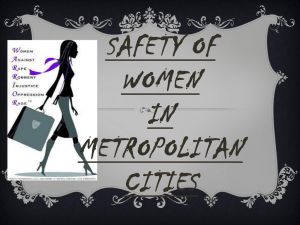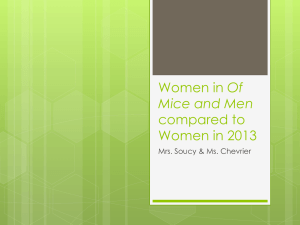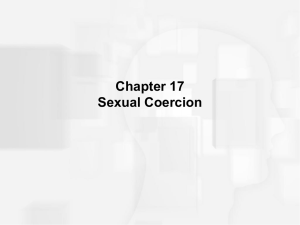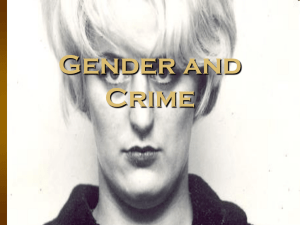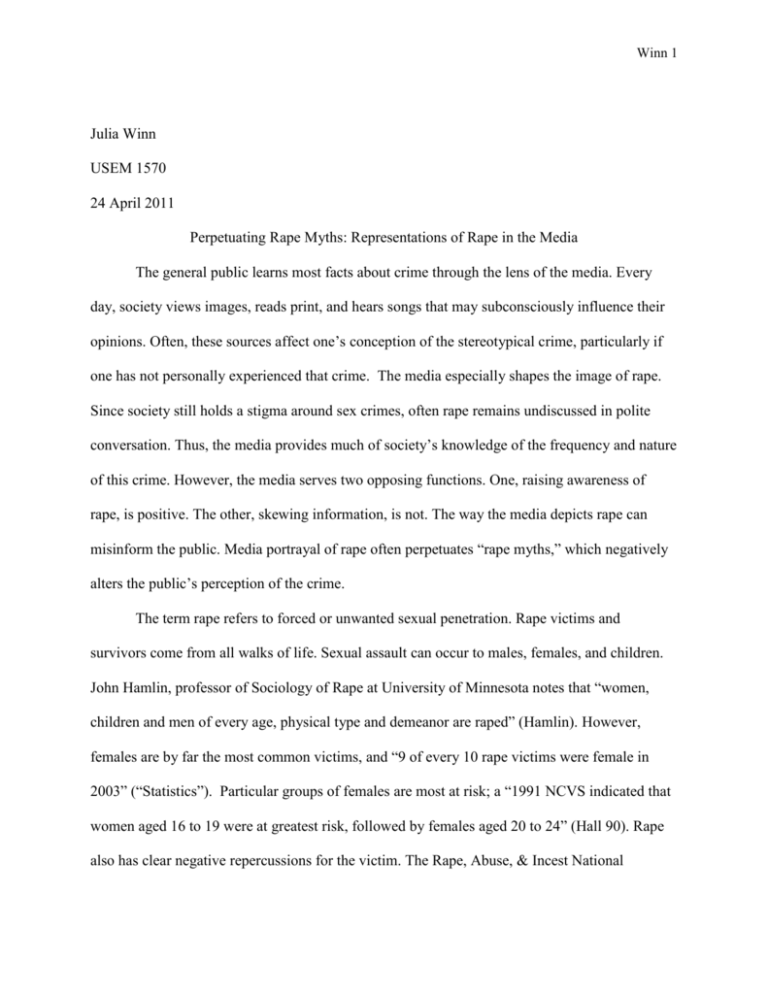
Winn 1
Julia Winn
USEM 1570
24 April 2011
Perpetuating Rape Myths: Representations of Rape in the Media
The general public learns most facts about crime through the lens of the media. Every
day, society views images, reads print, and hears songs that may subconsciously influence their
opinions. Often, these sources affect one’s conception of the stereotypical crime, particularly if
one has not personally experienced that crime. The media especially shapes the image of rape.
Since society still holds a stigma around sex crimes, often rape remains undiscussed in polite
conversation. Thus, the media provides much of society’s knowledge of the frequency and nature
of this crime. However, the media serves two opposing functions. One, raising awareness of
rape, is positive. The other, skewing information, is not. The way the media depicts rape can
misinform the public. Media portrayal of rape often perpetuates “rape myths,” which negatively
alters the public’s perception of the crime.
The term rape refers to forced or unwanted sexual penetration. Rape victims and
survivors come from all walks of life. Sexual assault can occur to males, females, and children.
John Hamlin, professor of Sociology of Rape at University of Minnesota notes that “women,
children and men of every age, physical type and demeanor are raped” (Hamlin). However,
females are by far the most common victims, and “9 of every 10 rape victims were female in
2003” (“Statistics”). Particular groups of females are most at risk; a “1991 NCVS indicated that
women aged 16 to 19 were at greatest risk, followed by females aged 20 to 24” (Hall 90). Rape
also has clear negative repercussions for the victim. The Rape, Abuse, & Incest National
Winn 2
Network claims that victims of rape are three times more likely to suffer from depression and six
times more likely to suffer from post-traumatic stress disorder than those who have not been
raped (“Statistics”). Rape is a devastating crime which affects a great deal of the American
population. According to RAINN statistics, one out of every six women in America has been the
victim of an attempted or completed rape in her lifetime (“Statistics”). Other sources claim even
higher rates.
The stereotypical rapist is a deranged male stranger. However, rape can be committed by
either sex, though most perpetrators are men and “over 80 percent of victims are assaulted by
someone they know or are newly acquainted with” (Smith 199). Also, rape perpetrators do not
necessarily suffer from mental disease; however, they do likely have some sort of behavioral
adjustment problem. For example, the “most apparent personality dysfunction of rapists was the
inability to form or maintain emotionally intimate relationships with other human beings” (Hall
74). Also, rapists “displayed little ability to trust, to sympathize or empathize, or to display
warmth with others” (Hall 74). Alcohol abuse also factors into the attributes of a rapist. A 1991
study found over 50 percent of sexual assault perpetrators to be alcoholics (Hall 75). So, rapists
have mental health issues either stemming from maladjustment or substance abuse, though not
necessarily actual sociopathology or sexual perversion.
Though the common stereotype is that rape occurs in a dark city alleyway, data garnered
from the 1997 Sex Offenses and Offenders Study states that, “more than 50% of all rape/sexual
assault incidents were reported by victims to have occurred within 1 mile of their home or at
their home” (“Statistics”). Therefore, rape is not just something that occurs in a dangerous city,
but rather a universal phenomenon. Even though rape affects so many women, the topic is not
Winn 3
often spoken about. That’s why the media plays such a crucial role in informing the public – and
if they skew the way they convey this information, then the results can be unfortunate.
Rape myths refer to stereotypes and constructs of rape which differ from the reality of the
crime. Many different sources contribute to these constructs, like media portrayal, family
custom, and classic gender roles. Several different rape myths still pervade the social mindset
today. One false assumption that the media perpetuates is the concept that stranger rape occurs
more frequently than acquaintance rape. As previously mentioned, “over 80 percent of victims
are assaulted by someone they know or are newly acquainted with” (Smith 199). However, the
media decreases the knowledge of the truth by focusing a disproportionate amount of news
coverage to cases involving stranger rape. This leads society to view “the classic ‘real’ rape…
[as a] rape by a stranger who uses a weapon – an assault done at night, outside, with a lot of
violence, resistance by the victim, and hence severe wounds and signs of struggle” (Parrot 27).
Though these cases should not be trivialized, nor should women cease to practice safety when
alone, the incidences of acquaintance rape should be reported more accurately. Due to the
disproportionate news coverage of stranger rapes, “some feminist critics charge that the media
purposefully provide stories saturated with ‘voyeuristic’ and sensationalized details” (Smith
125). Cases of stranger rape often provide more titillating details, rather than “boring” cases of
acquaintance rape. Thus, they receive more coverage.
Due to increased news and television coverage, the most famous rape cases are those of
stranger rape. Two excellent examples of stranger rape cases which garnered large amounts of
media attention are Big Dan’s Tavern case and the Central Park Jogger case. The former of the
two cases happened in 1983 in a New Bedford, Massachusetts bar where a “21-year-old mother
of two got up to leave…was grabbed, hoisted on top of a pool table, and repeatedly raped by a
Winn 4
group of men” (Smith 24). This gang rape “is remembered for the unprecedented attention it
garnered, primarily through live coverage of the trial by the Cable News Network (CNN)”
(Smith 25). The media portrayal of this case was especially influential because CNN hosted
“daily broadcasts, which repeatedly announced the young woman’s name to 2.5 nationwide
viewers, [which] resulted in other media sources dropping their policy of shielding a rape
victim’s name” (Smith 25). This case’s fame continued when two movies depicting the crime
ensued: a television movie Silent Witness and a movie starring Jodie Foster called The Accused
(Smith 25). Though the media attention surrounding this case positively raised awareness of
rape, it also served to perpetuate the conception of rape as a crime committed only by strangers.
Another example of such a big name case is the Central Park Jogger case, which occurred in
1989. This case involved a “well-educated, middle-class white female [who] was raped, beaten,
and left for dead” in Central Park by a group of black and Hispanic youths (Smith 39). This case
gathered a large amount of media coverage, possibly because “the media is more sympathetic to
the victim when a rape occurs between an upper middle class white woman and an AfricanAmerican assailant” (Kosse 243). Though the crime occurred over twenty years ago, it is far
from forgotten. The victim recently came forth and identified herself, publishing a book called I
Am the Central Park Jogger in 2002 (“Trisha’s Story”). Since the media coverage of stranger
rape cases tends to outweigh the coverage given to acquaintance rape cases, despite the fact that
acquaintance rape is more common, the general public may gain the wrong impression.
By limiting television coverage of acquaintance rape, several repercussions for the victim
arise. For example, this can “increase a survivor’s feelings of blame and shame, discourage [her]
from seeking help and reporting, and can harm [her] recovery…[and] allow society to minimize
or excuse the prevalence of rape and the effect it has on us all” (Smith 192). Society as a whole
Winn 5
gains a misconception about the reality of rape and what constitutes the “typical” rape from this
skewed media portrayal. Also, “if media articles advance narratives that are incomplete,
inaccurate or focus attention on irrelevant details, the public…may overlook the real issues
surrounding rape and make unfair judgments,” and gain misleading stereotypes of the typical
rape (Kosse 245). These negative outcomes emphasize the need to keep the public aware of the
real statistics.
Another important stereotype of rape that often occurs is victim blame. For instance, “one
of the most enduring rape myths is the belief that a woman cannot be raped against her will”
(Smith 27). This means that after a woman is raped, people wonder why she didn’t do more to
avoid it or fight her attacker. This places the victim under scrutiny, and questions her credibility.
Another stereotype of rape “that ‘good girls don’t get raped’ continues to affect rape survivors”
(Smith 28). This myth indicates that only females of loose moral character or provocative dress
will be raped. However, this rape myth is wrong on two accounts. First, not only “loose” women
are raped. As stated earlier, rape can occur to anyone. Second, simply because a woman dresses
provocatively or drinks does not mean she invites or deserves unwanted physical violence. By
analyzing the victim’s responsibility in the crime, this rape myth “makes scrutiny of their sexual
activity, as well as their dress and behavior, culturally acceptable” (Smith 192). The media
contributes to stereotypes such as these in the topics they chose to cover, the amount of press
given certain rapes, and even more subtle ways such as TV show plots.
The media also contributes to the rape myth of victim blame in sometimes unintentional
ways. The American legal system tends to question the victim intensely in order to maintain the
innocence of the accused until proven guilty. Although our system works well in theory, it can
essentially place the victim on trial. The way the legal system treats the victim transcends into
Winn 6
the news, “placing the burden of proof on rape victims” (Smith 27). Certain media portrayals
describe rape cases as though the woman brought the violence on herself. The media focuses a
disproportionate amount of attention on false rape accusations, which contributes to victim
blame. For example, the Duke lacrosse scandal (where three Duke lacrosse players were accused
of rape by a stripper, but were proven innocent) dominated TV and print news from 2006 to 2007
("Duke Lacrosse Incident"). This case generated a great deal of press time because it brought
notoriety to the academically prestigious school Duke. Though the press was well-deserved, the
fact that such allegations proved false has serious repercussions for actual rape victims. By
focusing so much attention on a false rape accusation, the media coverage only decreased
society’s sympathy and increased society’s skepticism towards potential rape victims. Another
example of the media focusing too much on false rape accusations is the case of Heidi Jones, a
weatherwoman who claimed to have been raped and then later retracted her statement. Due to
her slight celebrity as a Good Morning America weatherwoman, Jones’ story has gained media
attention across the country after she “admitted to cops that she fabricated the story as a bid for
sympathy” (Italiano). This case also leads society to assume that rape accusations may simply be
a desperate woman’s plea for attention.
The effects of this are misleading, because false rape accusations are much rarer than real
rape accusations. According to a study “by the American Prosecutors Research Institute, false
rape allegations account for two to eight percent of all reported rapes” (Irvine). However, press
coverage on these incidences tends to be great because a false claim usually ends in scandal.
Unfortunately, focusing so much attention on these accusations may have negative repercussions
for real victims. First, this leads to more victim blame, by assuming that a rape victim is probably
lying. Also, this effect discourages actual rape victims from coming forth with accusations.
Winn 7
When a woman actually has been raped, she may be “treat[ed]…as suspect from the beginning”
(Smith 27). In fact, “rape victims may experience postrape trauma as a result of these
nonsupportive reactions” (Suarez 2011). Though the media does not intentionally make speaking
up harder for victims, this can be the result of focusing a disproportionate amount of news on
false rape allegations.
Occasionally, the media contributes to victim less subtly, particularly in the wording of
print media. For example, an article recently published online in the New York Times about a
rape case described the victim in very unsympathetic terms. The article, “Vicious Assault Shakes
Texas Town,” describes the eleven-year-old victim of the Cleveland, Texas rape as “dressed
older than her age, wearing makeup and fashions more appropriate to a woman in her 20s”
(McKinley). This language biases the reader against the girl. Her style of dress or appearance in
no way condoned the violent acts that occurred to her, but by including this fact, the New York
Times seems to imply that it does. This article clearly perpetuates the stereotype that if the victim
“was flirting; if she was attractively dressed; if she was, in the man’s perception a tease…it was
her fault” (Parrot 31). Another example of an article blaming the victim comes from an Op/Ed
piece in the Chicago Sun-Times. Heather Mac Donald, the author, describes college as a “boozefilled sexual free-for-all” (Mac Donald). She denies the existence of campus rape victims (“they
don’t exist”) and gives patronizing advice to young women: “keep your clothes on” (Mac
Donald). While most readers easily recognize this as an extreme and misguided opinion piece,
words still have an impact on impressionable readers, particularly those who are out of touch
with current campus culture. Mac Donald clearly implies that “women are…deserving [of] rape
if they put themselves in risky circumstances, even when they have no choice but to do so”
Winn 8
(Parrot 32). Media portrayals of rape such as these two print examples serve to spread an
outdated rape myth that the victim is to blame for the crime.
Sometimes, the media even perpetuates a strange rape myth of rape as a symbol of
romance. Though no one consciously thinks of rape as romantic, the sexual nature of the crime
can lead to this assumption. Various television shows and movies also contribute to this effect.
Even classic movies, such as Gone With the Wind increased the belief in this rape myth. In Gone
With the Wind, drunken husband Rhett forcefully carries frightened Scarlett up the stairs one
night, leaving the ensuing violence to the viewer’s imagination. The next actual scene depicts
Scarlett looking radiantly happy and glowing in bed the next morning. These two scenes make
the violence seem like a bold romantic gesture from Rhett. Gone With the Wind depicts rape in a
dangerous way, “for it powerfully advertises the idea that women secretly wish to be
overpowered and raped” and it makes rape seem romantic or marriage-fixing (Finkelhor 14).
This example reinforces the stereotype that women like rape, otherwise they would fight it off
harder. On television, the soap opera General Hospital involved a romance started by rape. In a
1979 episode, “overcome by desire on an occasion when they were dancing together, Luke raped
Laura, the music swelling to a crescendo somewhat reminiscent…of Rhett’s sweeping Scarlett
up the stairs” (Fineman 110). Later, the soap opera couple married. Print ads can even glamorize
rape. One 2007 Dolce & Gabbana ad created controversy for its overtly sexual image (Reichert).
The ad depicts a female pinned down by her arms, surrounded by lecherous men standing around
her like vultures. It appears as if they are going to gang rape her. Subconsciously, the viewer may
associate this image of sexiness with rape, or a forced sexual encounter. Since the “advantage of
sex in advertising its ability to get noticed,” many companies may use highly sexual, even
violently, content in ads to attract attention (Reichert). Even though “the elements of an ad that
Winn 9
imply rape may be subtle…taken altogether the message of sexual violation becomes
clear”(Smith 4). These “threatening images continue to appear with disturbing regularity” (Smith
5). Movies, TV shows, and print ads depicting rape in a romanticized or glamorized way
continue to create an illusion that rape may be desired or romantic.
Rape is a pervasive crime which affects many people. Most women at least know of one
friend who has been sexually assaulted or raped. Due to the stigma surrounding it, many victims
may not report the crime in order to be spared the ordeal of going to court. When the media
portrays the victim as responsible for the crime, this contributes to a survivor’s fear of speaking
up. Though the media does a great job raising awareness of rape, by perpetuating out-dated
myths and stereotypes, the bad can sometimes outweigh the good. The news media could instead
focus equal amounts of coverage to both stranger and acquaintance rape and spend less time
discussing false rape allegations, so victims are not afraid of accusing their attacker. Fictitious
media sources, such as TV shows, movies, and advertisements, can more easily avoid
perpetuating rape myths. Plots where a rape victim falls in love with her rapist should not be
shown, as that is a highly unlikely and disturbing scenario. Though “sex sells” in the
advertisement world, these images need not look so menacing, and could look more consensual.
Movies also can influence the public positively by showing realistic rape scenes rather than
romanticized ones. Since the media infiltrates almost every arena of life, these sources must be
responsible for the way they present information.

